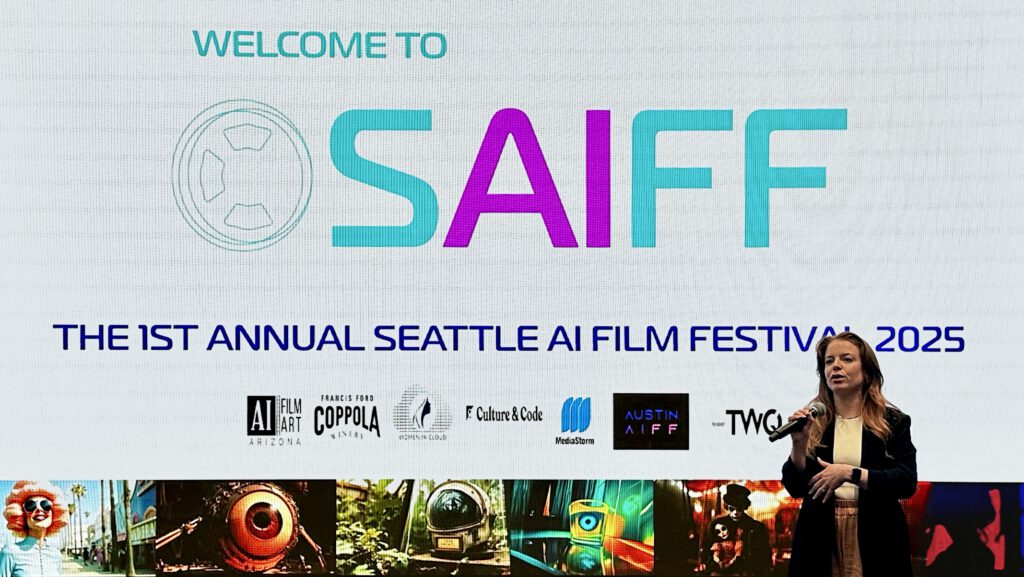Last weekend, I attended the inaugural Seattle AI Film Festival, an event that brought together filmmakers, technologists, and industry leaders to explore AI’s impact on visual storytelling. Among the speakers was Adrienne Lahens, who delivered a compelling talk on AI, creator economics, and entertainment’s future that particularly resonated with me.
Building the Economic Engine for the Imagination Age
Lahens describes our current moment as the dawn of “the Imagination Age”—an era where AI-powered creativity will transform how we create, distribute, and monetize content. Moreover, her balanced approach stood out in a field often divided by extreme viewpoints.

Instead of portraying AI as either a creative savior or destroyer, Lahens clearly outlined how different stakeholders must collaborate to build a sustainable economic engine. She addressed creators, developers, investors, and policymakers directly, emphasizing their unique responsibilities in shaping this new landscape. Consequently, she advocated for a system where creators protect their intellectual assets, technology companies integrate fair compensation models, investors fund creator-centric platforms, and regulators move with greater urgency to establish appropriate frameworks.
This practical approach highlights everyone’s role in creating a healthier creative economy. As a result, value flows back to all contributors—not just platform owners or AI companies.
From Vanity Metrics to Creative Fingerprints
The most powerful concept Lahens introduced was the shift from “vanity metrics” to “creative fingerprints.” Currently, creators measure success through likes, views, and follower counts—metrics that can be manipulated and rarely translate to sustainable careers.
In contrast, Lahens envisions a future where an artist’s unique creative signature becomes their most valuable asset. This idea connects deeply with my experience in immersive design, where distinctive creative vision typically outweighs viral metrics.
Furthermore, this concept ties into her prediction that “micro-IP” will define the Imagination Age. Rather than a few dominant franchises, we’ll see creator-owned intellectual property flourishing at various scales. Thus, more diverse voices can build sustainable careers from their creative work.
The Next Five Years: Predictions for the Imagination Age
Lahens shared several bold predictions for the creative landscape over the next five years. First and foremost, she foresees AI-native creators leading entertainment, with those who embrace AI as part of their creative toolkit gaining significant advantages.
She also predicted a fundamental shift in how talent gets discovered. Subsequently, the industry will move beyond follower counts and engagement rates toward valuing the uniqueness of a creator’s work—what she terms “creative fingerprints.”
Additionally, Lahens emphasized the growing importance of creator ownership. She described how smaller-scale intellectual property will thrive in the new landscape, enabling diverse voices to build sustainable creative businesses. Meanwhile, she envisioned tomorrow’s renowned storytellers crafting interactive universes rather than linear narratives—participatory storyworlds where audiences become active contributors.
Finally, she painted a picture of truly global entertainment, where democratized tools enable creator-owned franchises to emerge from all corners of the world, diversifying the stories being told.
These predictions align with trends I’ve witnessed at the intersection of technology and storytelling. During my work on shoppable video for LG TVs, I saw how new interaction models transform passive viewing into active engagement.
The Value Exchange in AI-Powered Creation
Lahens tackled the controversial issue of training data head-on. On one hand, she acknowledged artists’ legitimate concerns about their work being used without permission to train AI systems. On the other hand, she recognized the value created by AI developers and implementers.
The solution, according to Lahens, involves establishing fair value exchange models that compensate creators while fostering innovation. This balanced view offers a refreshing alternative to the polarized positions we often hear.
For those of us creating immersive and interactive experiences, this challenge remains especially relevant. Therefore, as we develop new forms of spatial computing and mixed reality, we must ensure creative contributors receive proper compensation for their work.
Conclusion: Building Together
Above all, what impressed me about Lahens’ talk was her constructive approach. Instead of just identifying problems, she presented a vision for stakeholder collaboration to build systems benefiting everyone.
As someone who has worked across design, technology, and business throughout my career, I found her integrative perspective particularly valuable. Obviously, no single discipline can solve the Imagination Age’s challenges alone—they require cross-disciplinary teamwork and mutual respect.
The festival itself embodied this collaborative spirit by connecting filmmakers, technologists, investors, and policy experts. Undoubtedly, this kind of cross-pollination will help us navigate the profound changes AI brings to creative industries.
Have you noticed a shift toward creative fingerprints in your work? How should we balance innovation and creator rights?